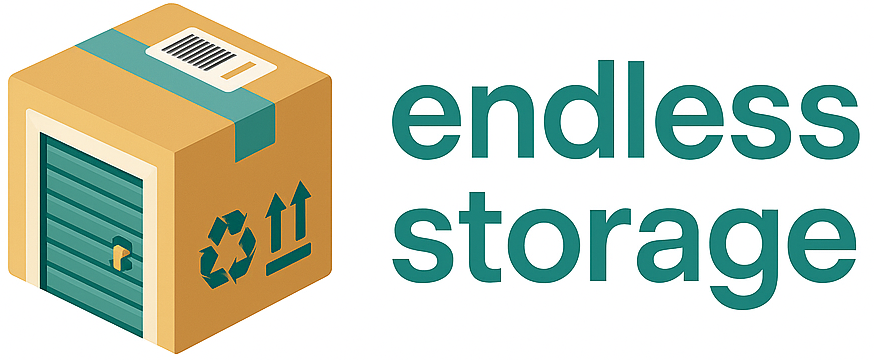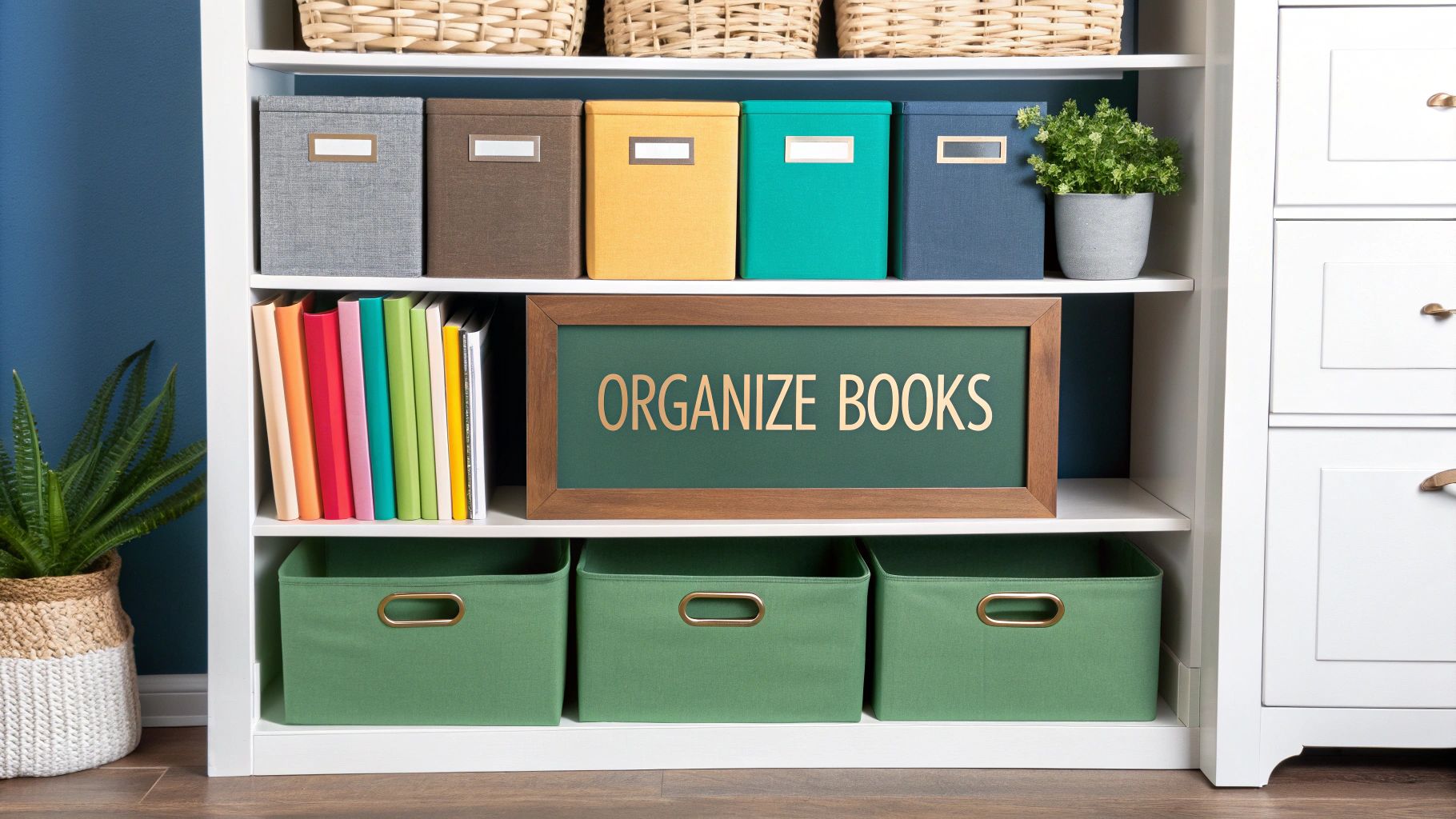For avid readers, a growing book collection is a source of joy, but it can quickly become a source of clutter. Towers of paperbacks teetering on a nightstand, beloved hardcovers double-stacked on shelves, and overflow stashed in boxes can make finding your next read a frustrating task. This isn't just about tidiness; it's about transforming your collection from a chaotic pile into a functional, personal library that reflects your tastes and enhances your living space. A well-organized library makes books more accessible, protects them from damage, and turns them into a beautiful decorative feature.
This guide provides a comprehensive list of practical and creative organizing books ideas to help you reclaim your space and rediscover your collection. We will explore seven distinct methods, moving beyond simple alphabetization to systems based on color, genre, reading status, and even aesthetic appeal. Each approach offers a unique way to think about your books, with actionable steps tailored for everyone from apartment dwellers with limited shelf space to homeowners looking to design a dedicated library. These strategies are about creating a system that works for you. For those looking for more hands-on approaches to home organization beyond books, consider exploring other DIY organizing solutions to tackle clutter in every corner of your home.
1. Color-Coded Organization System
A color-coded organization system moves beyond simple aesthetics to create a highly functional, visual library. This method involves assigning specific colors to different genres, topics, or even reading statuses, making it one of the most intuitive and immediate organizing books ideas. Instead of scanning endless titles, your eyes are drawn directly to the color representing the category you need, drastically cutting down search time.
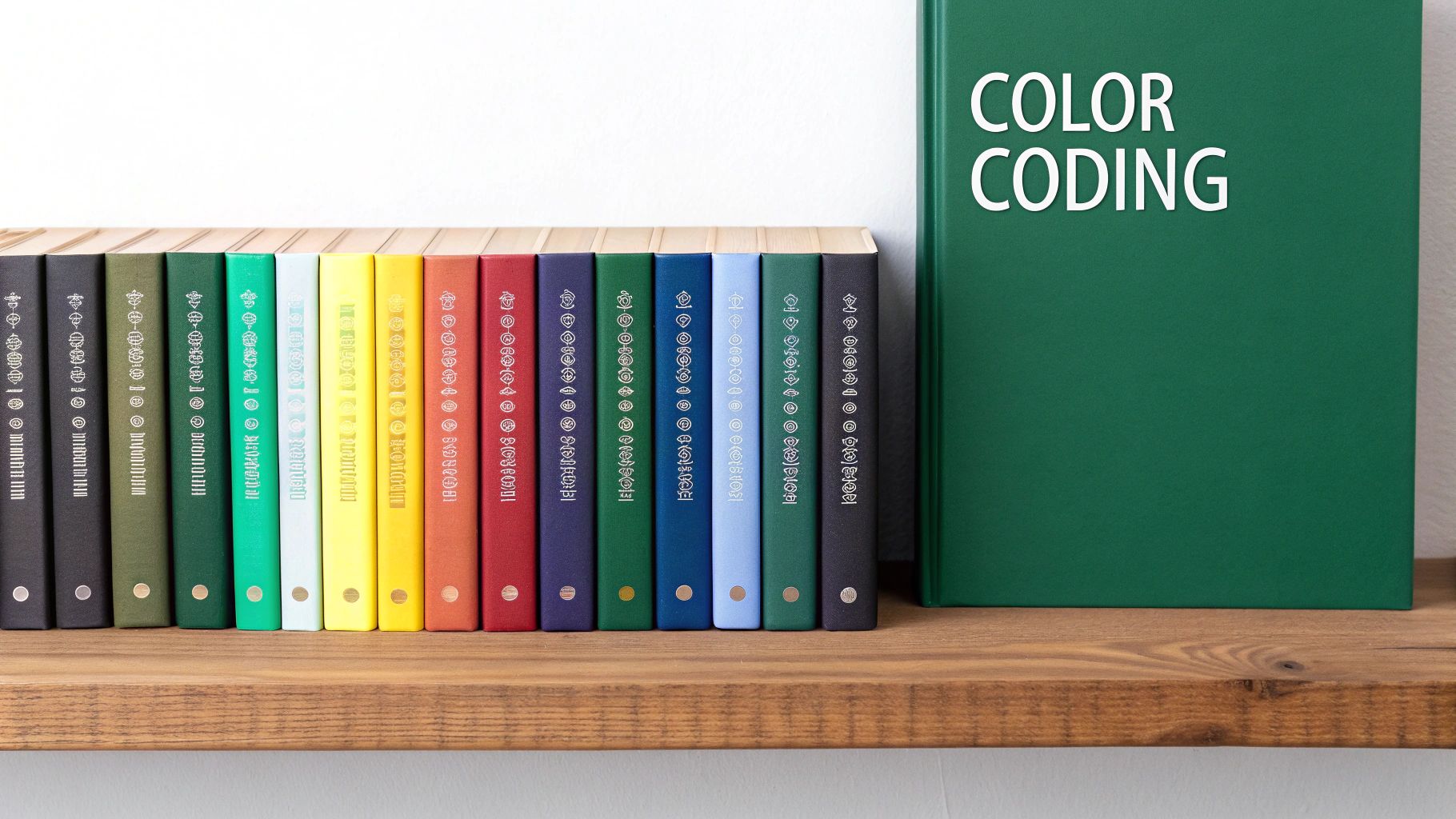
This system is surprisingly versatile and can be adapted for any collection size, from a small apartment bookshelf to a sprawling home library. It transforms your shelves into a functional map where colors act as clear signposts.
How It Works in Practice
The core principle is simple: use colored dots, spine labels, or even custom book covers to tag your books. You can see a similar concept applied in elementary school libraries, where different colors denote reading levels, helping young readers find appropriate books independently.
For personal collections, this approach offers endless customization. You might assign blue for historical fiction, green for science fiction and fantasy, yellow for biographies, and red for your "to-be-read" pile. The visual separation makes it easy to grab exactly what you're in the mood for. Bookstores also use a version of this with colored shelf talkers to highlight staff picks or new releases.
Actionable Tips for Implementation
To get started with your own color-coded system, consider these practical steps:
- Create a Key: Design a simple chart or legend that clearly lists which color corresponds to each category. Keep it near your bookshelf for easy reference.
- Use Removable Labels: Protect your books by choosing high-quality, acid-free, removable color-coding dots or labels. This prevents spine damage and allows you to easily re-categorize books later.
- Test First: Before committing, test your chosen labels on a few less valuable books to ensure they remove cleanly without leaving residue or pulling off any part of the cover.
- Start Broad: Begin with large, general categories like "Fiction," "Non-Fiction," and "Reference." You can always add more nuanced sub-categories later as your system evolves.
This method is particularly effective for visual thinkers and anyone looking to add a layer of systematic order that is both practical and engaging. You can find more inspiration and other great book organization ideas on the Endless Storage blog.
2. Dewey Decimal Classification System
For those with large or diverse non-fiction collections, the Dewey Decimal Classification System offers a structured, time-tested framework. Developed by Melvil Dewey in 1876, this internationally recognized system organizes knowledge into ten main classes, providing a standardized, scalable method for arranging books. It transforms your personal library from a simple collection into a navigable resource, making it one of the most robust organizing books ideas for serious readers and researchers.
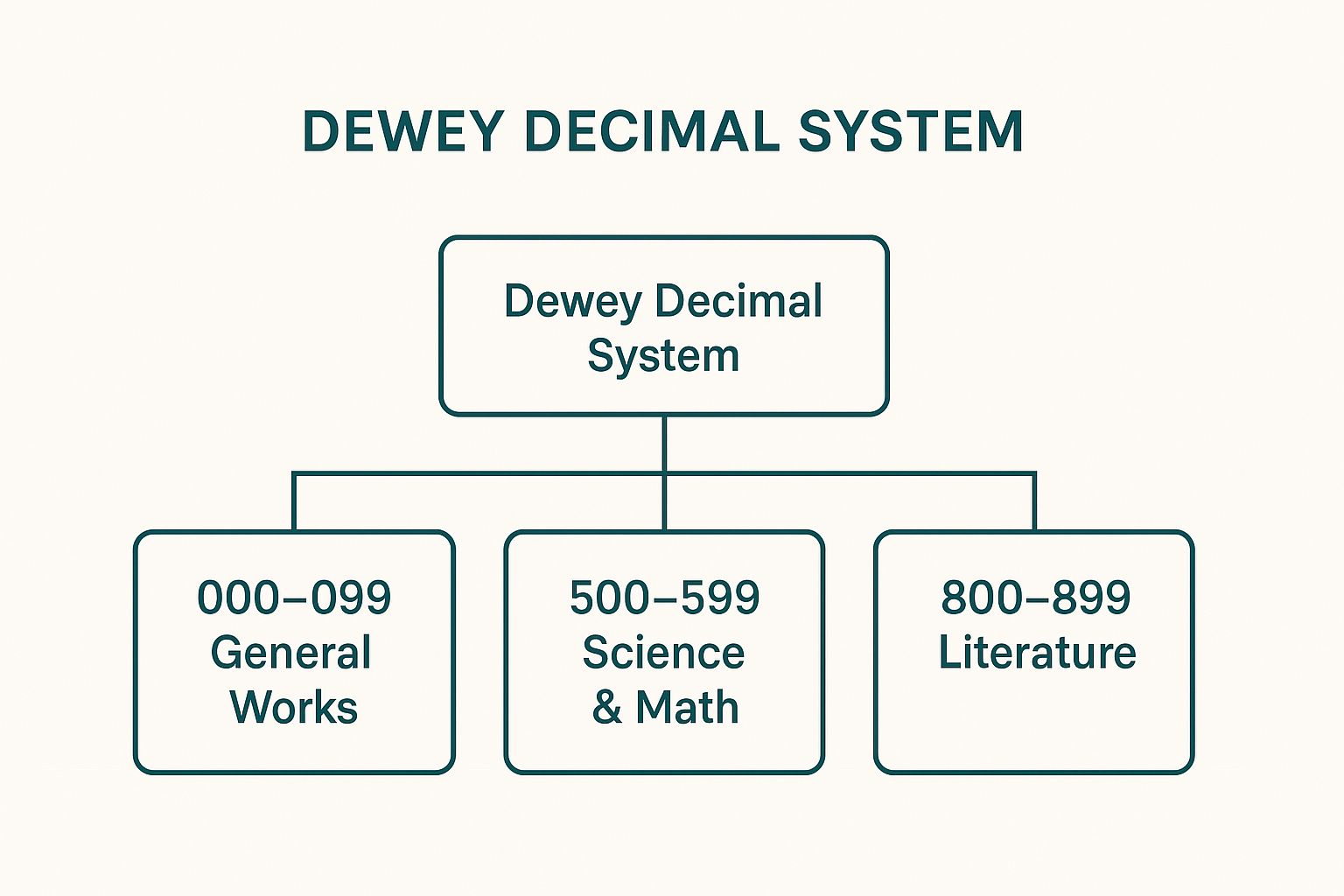
This hierarchical infographic shows how the system's root concept branches into broad categories like General Works, Science, and Literature, each represented by a number range. The structure allows for both broad sorting and highly specific sub-categorization, making it adaptable for any collection size.
How It Works in Practice
The Dewey Decimal System assigns a specific number to every subject, allowing you to shelve books logically by topic rather than by author or title. For example, all books on science are grouped in the 500s, while history and geography are found in the 900s. This is the same system used by most public and school libraries worldwide, making it instantly familiar to many.
For a personal collection, you don't need to be as granular as a major library. You can use the ten main classes to create broad sections on your shelves, such as "Philosophy & Psychology" (100s) or "Arts & Recreation" (700s). This method is especially useful for those with significant non-fiction holdings, as it keeps related topics physically together, facilitating research and browsing.
Actionable Tips for Implementation
Implementing a home version of the Dewey Decimal System is more manageable than it sounds with these steps:
- Start with the Main Classes: Begin by sorting your books into the ten main categories (000-999). Don't worry about detailed sub-categories at first.
- Use Online Tools: Websites like the OCLC's Classify service can help you find the correct Dewey number for your books by searching their title or ISBN.
- Create Spine Labels: Use a label maker or small stickers to clearly mark each book's spine with its Dewey number. This is crucial for maintaining order.
- Focus on Your Interests: If your collection is heavily concentrated in one area, like technology (600s), you can implement more detailed sub-categories for that section while keeping others broad.
This approach is perfect for academics, lifelong learners, and anyone whose library serves as a functional reference tool, bringing professional-grade organization into your home.
3. Alphabetical Organization
Alphabetical organization is a timeless and universally understood method for arranging a book collection. This system files books alphabetically, most commonly by the author's last name. It's a highly logical approach that transforms your bookshelf into a personal index, making any specific title easy to locate. This straightforward technique is one of the most reliable organizing books ideas, valued for its simplicity and efficiency.
This classic method scales effortlessly, working just as well for a modest collection of paperbacks as it does for an extensive library. It eliminates guesswork and is incredibly intuitive for guests who might want to browse your shelves, as most people are already familiar with how it works from visiting bookstores and libraries.
How It Works in Practice
The fundamental principle is to sort books from A to Z. For fiction, this is typically done by the author's last name. For non-fiction, you can alphabetize by title or by subject, depending on how you prefer to search for information. This system brings a clear, predictable order to your collection.
You’ve seen this system everywhere, from the fiction aisles of major bookstores to the structured shelves of academic libraries. A home library might have a fiction section sorted by author (Austen, Brontë, Christie) and a separate non-fiction section sorted by title. This dual approach ensures you can find a novel by your favorite writer or a specific cookbook with equal ease.
Actionable Tips for Implementation
To set up a robust alphabetical system, follow these practical steps:
- Establish Clear Rules: Decide how you will handle prefixes like "A," "An," and "The." Most systems ignore these for filing purposes, so The Great Gatsby would be filed under 'G'. Be consistent with your rule.
- Use Alphabetical Dividers: For larger collections, shelf dividers labeled with letters (A-C, D-F, etc.) can be a massive help. They act as signposts, guiding your eye to the right section quickly.
- Separate Formats if Needed: You may find it useful to create separate alphabetical sections for different formats, such as paperbacks, hardcovers, and audiobooks, to maintain a cleaner look.
- Handle Series Thoughtfully: Decide whether to file a book series under the author's name together in chronological order or to file each title individually. Keeping them together is often more practical.
This method is ideal for readers who know exactly which author or title they are looking for and value precision over aesthetics. To maintain order, especially with books in storage, effective labeling is key. You can find some great tips for this in our guide to the best ways to label storage bins on the Endless Storage blog.
4. Genre-Based Organization
A genre-based organization system is a classic and highly effective method that groups books according to their subject matter or literary category. Instead of arranging by author or title, this approach creates distinct, browsable sections like mystery, science fiction, biography, or history. This is one of the most popular organizing books ideas because it mirrors how most people decide what to read next: by mood or interest.
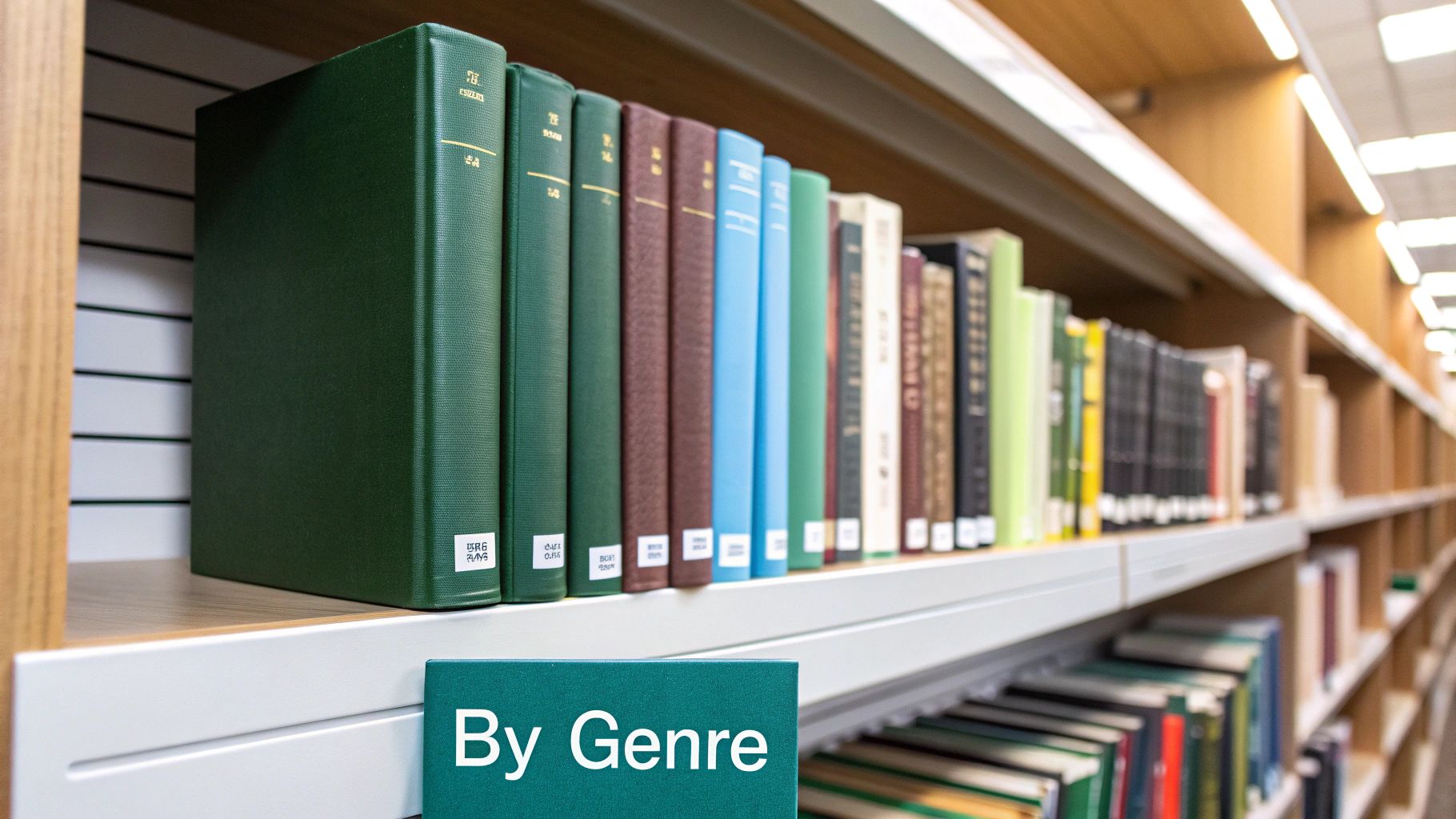
This intuitive system transforms your bookshelf into a personal bookstore, making it easy to find a specific type of story or explore similar titles within a category you already love. It’s ideal for readers who have diverse tastes and enjoy switching between different worlds, from thrilling suspense to in-depth historical accounts.
How It Works in Practice
The fundamental principle is to sort your entire collection into predefined categories that make sense to you. This is the standard model used by virtually all public libraries and retail bookstores. They create clear sections for romance, fantasy, and non-fiction topics like cooking or self-help to guide customers directly to their areas of interest.
For a personal library, you can tailor the categories to your collection. You might have a large section for Fantasy, a smaller one for Classic Literature, and a dedicated shelf for Business & Finance. This method not only simplifies finding a book but also helps you visually assess your collection, revealing which genres you gravitate towards most and where you might want to expand.
Actionable Tips for Implementation
To set up a functional genre-based system, follow these practical steps:
- Define Your Categories: Before you start sorting, make a list of the genres in your collection. Be specific but flexible; start with broad categories and create sub-genres (like "High Fantasy" and "Urban Fantasy") only if a section becomes too large.
- Use Shelf Labels or Dividers: Clearly mark where one genre ends and another begins. You can use simple adhesive labels on the shelf edge or purchase stylish book dividers to create a clean, organized look.
- Create a "Miscellaneous" Section: Not every book will fit neatly into a single category. Designate a shelf for "General Fiction," poetry, short story collections, or other unique books to avoid organizational headaches.
- Review and Adjust: Your reading tastes and collection will change over time. Periodically review your categories and be willing to reorganize, merge, or create new sections as needed to keep the system functional.
This method is perfect for avid readers who want to browse their shelves by interest and easily find their next great read. To dive deeper into this and other systems, you can learn more about how to organize your book collection on the Endless Storage blog.
5. Reading Status System
A reading status system organizes your library based on your personal journey with each book. This method prioritizes your direct relationship with your collection, categorizing books into groups like "To Read," "Currently Reading," and "Already Read." It's one of the most dynamic and personal organizing books ideas, transforming a static collection into an active reflection of your reading habits and goals.
This approach is especially powerful for active readers, book club members, or anyone participating in reading challenges. It turns your bookshelf into a functional dashboard for tracking progress, keeping your reading goals front and center rather than hidden among less relevant titles.
How It Works in Practice
The core idea is to physically separate your books according to their role in your current reading life. A dedicated shelf or section for your "To-Be-Read" (TBR) pile keeps future reads visible and exciting. Your "Currently Reading" stack might live on your nightstand, while completed books are given a permanent home on a main "Read" shelf.
Many digital tools, like the shelves on Goodreads, are built around this exact concept, allowing users to track their reading progress virtually. In a physical space, you can achieve the same clarity. A book club member might have a shelf for upcoming selections, while a student could separate required reading from leisure books, making it easy to see what needs immediate attention.
Actionable Tips for Implementation
To implement a reading status system effectively, try these practical steps:
- Use Clear Dividers: Employ moveable bookends or subtle shelf dividers to create distinct, visible zones for each status. Label them clearly: "To Read," "In Progress," "Finished."
- Set Realistic Limits: Be honest about your reading capacity. A towering "To Read" pile can be demotivating, so consider a "one in, one out" rule or limit the pile to a manageable number.
- Track Your Progress: For those who enjoy marking their progress visually, there are 10 creative ways to use sticky notes and tabs for better organization that can help you tag books without causing damage.
- Celebrate Completions: Make moving a book from the "Currently Reading" stack to the "Read" shelf a small ceremony. This reinforces a sense of accomplishment and keeps the system engaging.
This method is perfect for goal-oriented readers who want their shelves to reflect not just what they own, but what they are actively experiencing.
6. Size and Aesthetic Organization
A size and aesthetic organization system treats your book collection as an integral part of your home's decor. This visually-driven approach prioritizes the physical dimensions and appearance of books over their content, arranging them by height, color, or overall visual appeal to create a cohesive and pleasing display. While sometimes debated by literary purists, this method is one of the most effective organizing books ideas for integrating a collection seamlessly into your living space.
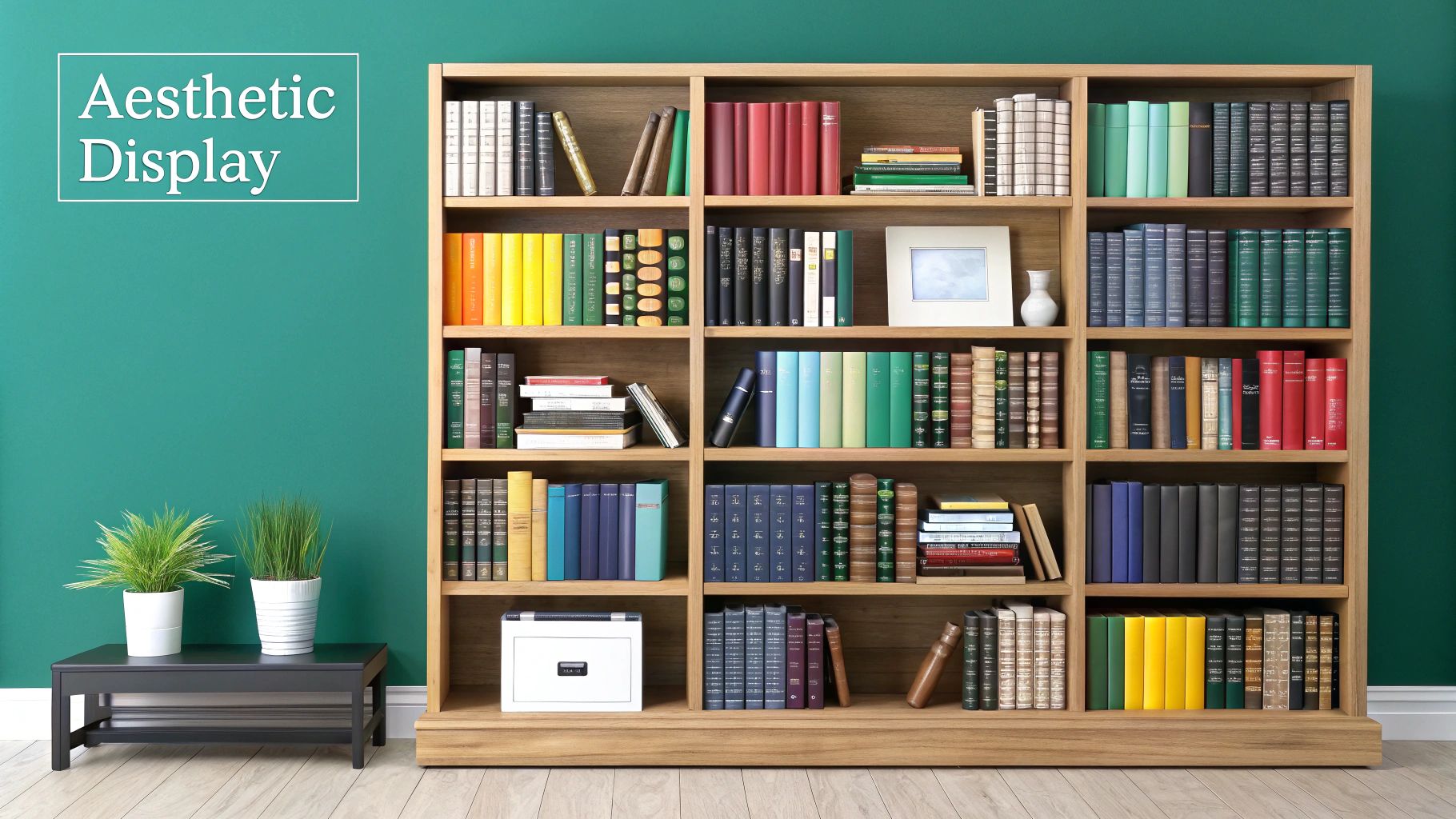
This system is perfect for those who view their books as both intellectual and decorative objects. It transforms standard shelves into a curated exhibit, often seen in interior design showcases, boutique hotel libraries, and stylish home tours where books contribute to the room's overall ambiance.
How It Works in Practice
The core principle is to create visual harmony. This could mean arranging books in a gradient from tallest to shortest, creating an orderly, cascading effect. Another popular technique is to group books with similarly colored spines together to form blocks of color, similar to a rainbow arrangement but focused on aesthetic flow rather than a strict categorical system.
In practice, this method turns book organization into an art form. You might see a shelf where all the tall, black-spined art books are grouped together, flanked by a shorter stack of white paperbacks, creating a dramatic contrast. Beyond the arrangement of the books themselves, the furniture housing your collection significantly impacts the overall aesthetic. Consider incorporating beautifully designed shelving to elevate your home library's visual appeal.
Actionable Tips for Implementation
To implement an aesthetic-first system without losing all function, try these tips:
- Create a Digital Catalog: Use an app like Goodreads or Libib to scan barcodes and create a digital record of your library. This allows you to search for a book by title or author when you can't remember its size or color.
- Try a Hybrid Approach: You don't have to abandon genre completely. Dedicate one shelf to aesthetic arrangement while keeping your most-used books (like cookbooks or current reads) grouped by subject on another.
- Group by Size and Publisher: Often, books from the same publisher or series share similar dimensions and design elements. Grouping them together creates a naturally clean and uniform look.
- Use Bookends and Risers: Employ decorative bookends to frame your arrangements and use small risers or stacks of horizontal books to vary heights and add visual interest.
This method is ideal for making your collection a focal point of your decor. You can discover more about balancing form and function by exploring the best way to store books on the Endless Storage blog.
7. Frequency of Use System
A frequency of use system is one of the most practical and ergonomic organizing books ideas, prioritizing accessibility over aesthetics or strict categorization. This method arranges books based on how often you actually use them. Your most frequently referenced or read books are placed in prime, easy-to-reach locations, while less-touched volumes are stored on higher or lower shelves.
This user-centric approach ensures your library works for you, not against you. It eliminates the frustration of digging for a daily reference guide or a favorite cookbook, making your collection feel more intuitive and responsive to your daily habits. It’s a dynamic system that adapts to your life.
How It Works in Practice
The core principle is to treat your bookshelf space like valuable real estate. Prime locations, typically at eye level and within arm's reach, are reserved for high-traffic books. This concept is widely used in professional settings, such as an academic library's reserve collection where required course readings are kept for easy access, or a chef's kitchen where essential cookbooks are always handy.
In a home office, this means your go-to professional handbooks and manuals are right next to your desk. In the living room, your current reads and favorite comfort novels might occupy the most accessible shelf. This method transforms your bookshelf from a static display into a functional, highly efficient tool tailored to your personal needs.
Actionable Tips for Implementation
To implement a system based on frequency of use, consider these practical steps:
- Conduct a Usage Audit: Periodically review your collection. Ask yourself, "When was the last time I opened this book?" This simple audit will help you identify which books deserve a prime spot.
- Reserve Prime Real Estate: Intentionally place daily-use references, current "to-be-read" books, and all-time favorites on shelves between your waist and shoulder height.
- Consider Seasonal Rotation: Books related to specific seasons or hobbies (like gardening guides in spring or holiday cookbooks in winter) can be rotated into more accessible spots as needed.
- Track Your Habits: For a data-driven approach, place a small, removable sticky tab on the spine each time you use a book. After a few months, the books with the most tabs are clearly your most-used ones.
This system is particularly effective for those with work-related or hobby-specific collections where quick access is crucial. For more insights on maximizing utility in your space, you can explore strategies to organize small spaces for clutter-free living.
7 Methods for Organizing Books Compared
Crafting Your Perfect Library
Navigating the world of literature is a journey, and how you arrange your collection should be just as personal and rewarding. We've explored a diverse landscape of organizing books ideas, from the vibrant visual appeal of a color-coded rainbow to the structured logic of the Dewey Decimal System. Each method offers a unique lens through which to view and interact with your personal library, transforming a simple pile of books into a curated, functional, and beautiful part of your home.
The key takeaway is that there is no single "correct" way to organize your books. The ideal system is the one that aligns with your lifestyle, your space, and how you engage with your collection. Whether you're an aesthetic-driven decorator, a meticulous archivist, or a practical reader focused on what's next, the perfect solution exists within the strategies we've discussed.
Your Path to a Curated Collection
To begin your organizational journey, consider these actionable next steps:
- Assess Your Collection: Start by taking a full inventory. Understand the size, genres, and physical dimensions of your books. This initial assessment is crucial for choosing a system that will actually work for you.
- Define Your Goal: What is your primary objective? Are you aiming for visual harmony, easy access to your most-used books, or a system that helps you track your reading progress? Be clear about what you want to achieve.
- Experiment and Combine: Don't be afraid to mix and match. Perhaps you organize by genre, but within each genre, you arrange books by size for a cleaner look. The most effective systems are often hybrid solutions tailored to individual needs.
Mastering these approaches is about more than just tidying up; it's about reclaiming your space and deepening your relationship with the stories you love. An organized library reduces clutter, saves time, and turns your collection from a source of stress into a source of inspiration. It creates an environment where your books are not just stored but celebrated, ready to be discovered and enjoyed all over again.
Ultimately, your bookshelf is a reflection of your own story, a physical timeline of your interests, passions, and intellectual adventures. By thoughtfully implementing these organizing books ideas, you are not just arranging paper and ink; you are crafting a personal sanctuary that nurtures your love for reading and brings a sense of order and beauty to your daily life.
When your personal library outgrows your living space, you don't have to part with your beloved books. Endless Storage offers a perfect solution, providing secure, climate-controlled units to protect your collection until you need it. Visit Endless Storage to discover how you can easily store your overflow and keep your home beautifully organized.
Frequently Asked Questions
Unveiling the Secrets to Effortless Storage
Endless Storage is available nationwide. You pick a plan, tell us where to pickup, and we'll send a UPS van to collect, whichever state you're in.
Your shipping label will be sent to your email within a few minutes, if not instantaneously. It can also be accessed through your customer profile.
Your box will be shipped to one of our climate controlled self storage facilities in our closest self storage facility. Our manager will accept your package, notify you that your box has been received, and securely stored. Only our managers will have access to Endless Storage boxes.
Email us at admin@endless-storage.com click to live chat with us, or send us a message below.
Never! We're committed to transparent pricing with no surprises. You'll lock in your rate with no hidden fees and no long-term contracts.
Fast access guaranteed! Your boxes will arrive at your doorstep within 48 hours of requesting them back. Need to check on delivery? We provide tracking information for complete peace of mind.
Totally flexible! Store month-to-month with no long-term commitment and cancel anytime.
Everything's online! Use your account dashboard to:
• Set up automatic monthly payments
• Request box returns
• Update your address
• Order additional boxes
• Track shipments
Your boxes are insured up to $100 each. Our customer service team will help you file any necessary claims and resolve issues quickly.
Don't worry – we'll email you right away if there's a payment issue. Your items stay safe, though you may have temporary service interruption or late fees until payment is resolved.
When you request our free storage kits, you'll have 30 days to send in your boxes to activate your 3 months of free storage. Think of it like starting a gym membership – your activation window begins when you receive your kits, and your full free trial begins once you send in your first box. During your free months, you'll experience our complete storage service at no cost.
Your 30-day activation window begins when you receive your storage kits. We'll send you an email confirmation when your kits are delivered, marking the start of your activation period.
If you haven't sent any boxes for storage within your 30-day activation window, your free trial will expire and we'll begin charging the regular monthly rate of $9.99 per box. This helps ensure our storage kits go to customers who are ready to use our service.
A box costs $9.99 per month to store (plus sales tax). This price includes free shipping for standard boxes under 50 lbs. and smaller than 16"x16"x16"
Log into your Endless Storage account, locate the box you would like returned, and simply click Return My Box.
Yes, each box stored with us is insured for up to $100 throughout transit as well as the duration of storage within our facilities.
Your box will be at your doorstep within 48 hours of you requesting it back.
Store 10+ boxes? We'll pick them up for free! After your purchase, we'll contact you to schedule a convenient pickup time and arrange UPS collection.
We trust UPS with all shipments, and every box includes $100 insurance coverage. You'll receive tracking information to monitor your items' journey.
Yes! Visit any of our locations by appointment. Just bring a photo ID matching your customer profile.
For everyone's safety, we can't store hazardous materials, firearms, or perishables. All items must fit within our standard boxes.
It's easy! Order your storage kit online, and we'll ship it to you within 1-2 business days. Your shipping labels will be emailed instantly and available in your account.
We're here to help! Email us at admin@endless-storage.com, use our live chat, or send us a message through your account.
To cancel your storage service with Endless Storage, please email your cancellation request to admin@endless-storage.com. Our team will process your request within 2 business days and confirm your cancellation via email.
We understand packing takes time. However, to maintain your free trial benefits, you'll need to send at least one box within the 30-day activation window. If you need more time, you can always start with one box to activate your trial and send the rest later. You can always reach out to admin@endless-storage.com if you have any issues or concerns.
When you request our free storage kits, you're starting a 30-day window to begin using our storage service.
To avoid any charges, simply send at least one box for storage within 30 days to activate your 3-month free trial. If you decide not to use our service and don't send any boxes within the 30-day window, a one-time $50 fee will apply to cover the costs of materials and shipping. This helps ensure our storage kits go to customers who are ready to use our service.
Think of it like reserving a hotel room – we're setting aside space and sending specialized packing materials for your use. The fee only applies if you request materials but don't begin storage, similar to a hotel's no-show charge.
